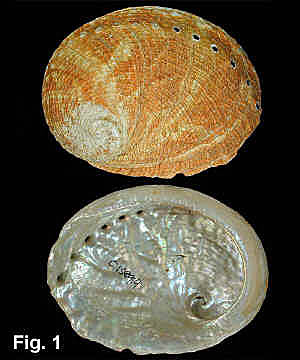|
|
|
|
|
Haliotis rubra Leach, 1814 Description : Specimens from NSW sculptured with irregular, coarse radial or oblique folds, poorly developed in juveniles, and fine scaly spiral ribs. Shell angled at the row of siphonal holes, the last 6-8 open; wide groove below angle. External colour terracotta red, occasionally streaked with light green; interior silvery iridescent. Size : Up to about 200 mm wide. Distribution : Endemic to Australia; Angourie, NSW, to Fremantle, WA, including Tasmania. Habitat : In crevices, caves, fissures and on vertical rock surfaces, from low tide to 40 m. Common. Comparison : This is the only abalone that grows over 75 mm in NSW, so large specimens are easily identified. Juvenile specimens are sometimes difficult to separate from H. coccoradiata. For differences, see discussion of that species. Synonyms : Haliotis naevosa Martyn, 1786; Haliotis conicopora Péron, 1816; Haliotis cunninghami Gray, 1826; Haliotis granti Pritchard & Gatliff, 1903; Haliotis improbulum Iredale, 1924; Haliotis vixlirata Cotton, 1943; Sanhaliotis whitehousei Colman, 1959 is known only from the holotype, which is a distorted specimen with the apex close to the margin. Shell form varies considerably throughout the range, with six forms having been assigned specific names, now regarded as synonyms. The most distinctive form is that which occurs in south-western WA, where shells have a high spire and flattened dorsal surface, in contrast to the rounded dorsal surface of eastern shells; the western shells have been known as Haliotis conicopora Péron, 1816. Remarks : This species lives from low tide down to about 40 m, on rocky surfaces of both exposed and sheltered waters, with adults hidden in caves, fissures or narrow crevices, or on vertical rock faces (Shepherd, 1973). Small animals live under boulders, moving to more exposed situations as they grow. This species grazes on drift algae and algae growing on rock surfaces; they capture drift algae or overhanging kelp fronds by raising the front of the foot and trapping it. They seldom move far (except sometimes in stormy weather) and generally remain fixed to a particular spot on the rock. If this spot is so placed that the current or surge transports drifting algae to the abalone, the animal will grow rapidly. In areas where water movement is poor, or algae is seasonally scarce, then the abalone has a poorer food supply and grows only slowly or seasonally. Predators vary according to the size of the abalone. Young abalone during their crevice-living phase are preyed upon by whelks, crabs, octopus and wrasses. Adult abalone is eaten by fish, octopus, rock lobster, stingrays and starfish. Abalone are ‘broadcast fertilisers’. That is, eggs and sperm are shed freely into the water where fertilisation takes place. Spawning takes place between February and April and again between October and December. At an age of one year the shell length is about 25 millimetres, at five years about 130 millimetres and at six years about 145 millimetres. In some locations growth is faster, in other locations growth may be slower. Lifespan is about 15 years with a maximum length of 150 to 220 mm. Abalone taken from the wild constitutes a major industry in southern Australia. In 1998/99, the catches of all abalone species by state were: NSW – 323 tonnes; Victoria – 1,435 tonnes; Western Australia – 340 tonnes; South Australia – 933; and, Tasmania – 2,559 tonnes; about 80% of the take was Haliotis rubra. Most abalone are detached from the shell then canned or individually quick-frozen, but a small proportion of the catch is exported live to interstate and Asian markets. About two thirds of the production is exported, mainly to Japan, Taiwan and Hong Kong. A recent development is the farming of abalone in on-shore tanks. Spat are produced in specialist facilities, and distributed to grow out facilities where they are grown to maturity in tanks. This requires a constant flow of well-aerated sea water. The growing abalone are fed on a pelletised food, sometimes supplemented with algae harvested from the sea . Fig. 1: Off Eden, NSW (C.138919) |
